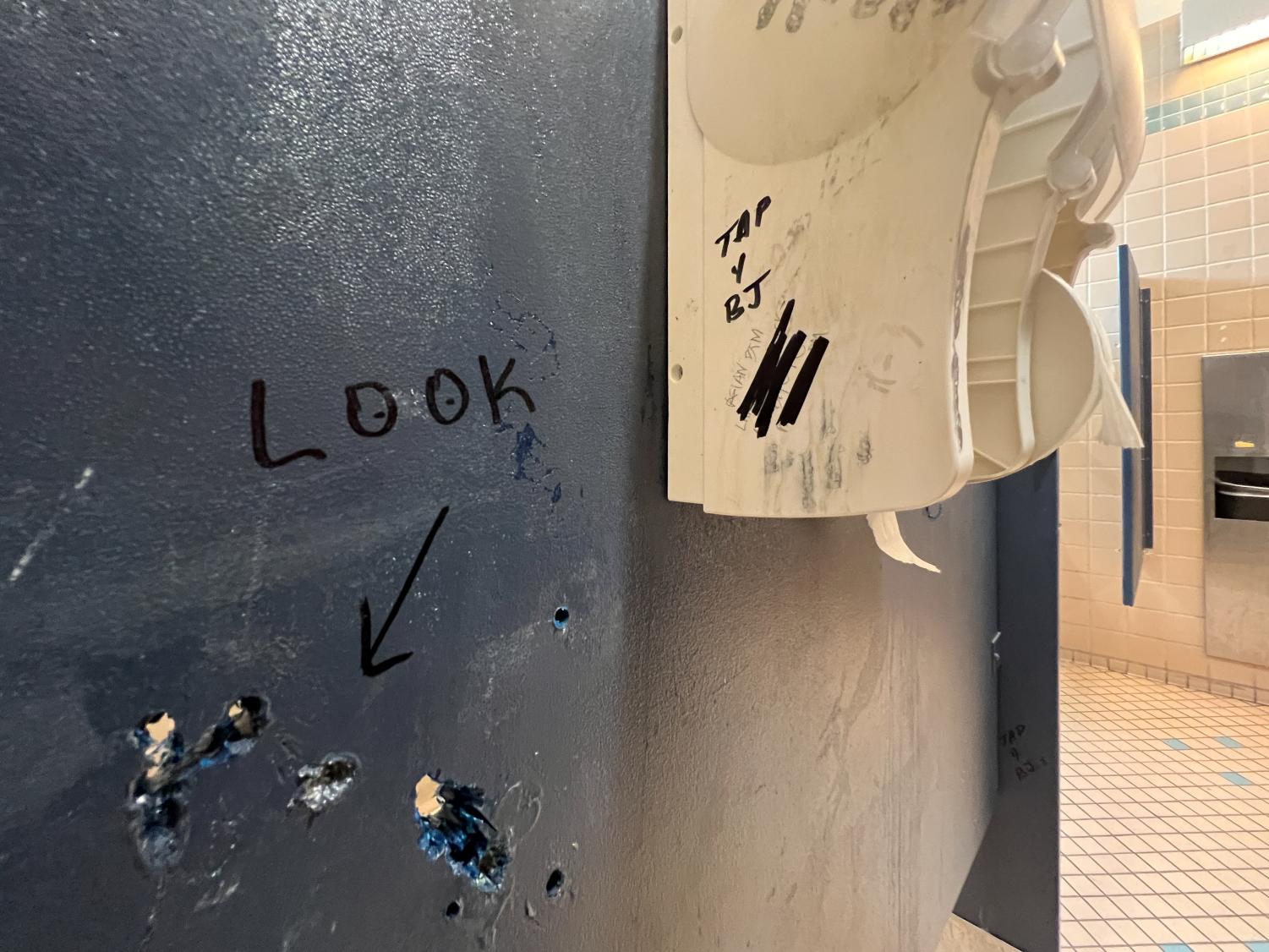
SF State bathrooms: a public setting for private encounters
Cruising for sex has been a part of gay culture for decades; SF State’s campus is no exception to this.
December 15, 2022
Dried, white stains coat the blue stalls of the third-floor bathroom in SF State’s Humanities Building. The remnants decorate the borders of several jagged peepholes carved into the stalls’ dividers.
The south wing of the Humanities Building has some of the only bathrooms on campus that have a two-door entrance, with a mini foyer separating the hallway and the bathroom.
Members of Squirt.org – a gay and bisexual hookup site – noted the double doors, “so you can hear if someone is coming in.”
Inside is an unused, wooden doorstop. On the right side, sinks and urinals line the walls; on the left are three connected toilet stalls and a lone handicap-accessible stall at the end.
The bathroom is listed as “HUM” on Sniffies – another meetup site specifically tailored for “cruising” that gained traction during the COVID-19 pandemic. According to A Modern Gay’s Guide, cruising “is the act of looking for sexual partners at a ‘beat.’”
Sniffies users describe the bathroom as a “Campus Spot for Fun,” accompanied by “Most popular for cruising on weekdays in the afternoon” and a thumbs-up icon labeling it “very popular.”
One user – who only identified themself as “Straight-curious, top” – left replies under the listing at the start of the semester: “Orgy at hum who wanna start it off?” and “Who here type shi I’m tryna get an orgy.”
Sniffies users reported 44 visits to the third-floor bathroom that day and hundreds each month.
In October, “WET PAINT” signs hung on stall doors after a fresh coat of paint was applied, though the separating stall dividers with the peep-holes still had history splattered on them.
The earliest online record of this cruising spot was in 2001 when an unknown user listed it on CRUISING for SEX, less than a decade after the Humanities Building was erected in 1994. It’s since appeared on Squirt and Cruising Gays – other dating and meetup apps, which are known for access to quick, often anonymous hookups at public meetup spots.
While the Humanities’ bathroom gets the most foot traffic, other locations on campus appear on Sniffies as active cruising spots including specific rooms in the J. Paul Leonard Library, Thornton Hall and the HHS Building, all of which include short descriptions and the best time to visit.
“Locker room and shower in old gym,” one listing suggests. “Athletes come here so be discreet. Open showers and restrooms to play in, can easily hear people coming. Afternoons and evenings are best times.”
This phenomenon isn’t unique to SF State; college campuses across the nation are a hotspot for cruising. UCLA, George Washington University and Ohio State University have records of it.
Jose was 18 years old when he first cruised. His initial encounter was at Orange Coast College in southern California, in a bathroom outside a chemistry lab at the very back of campus. The bathroom rarely saw visitors.
“I’m going to the restroom and I get to doing other stuff waiting for class,” he said. “Someone joins the stall next to me. They’re doing the same thing. You know, shoes move closer to each other. And that was my first experience with that.”
In bathroom stalls, a tap of the foot is the most common signal for cruising. Jose wasn’t familiar with cruising before that, so he didn’t anticipate it, but followed the lead.
“It was a rush, heart pumping like, ‘Oh my God, what’s happening?’” Jose explained.
He has since cruised on various campuses across California after transferring to UC Davis for his undergraduate degree and while pursuing his master’s degree at CSU Long Beach.
“By then I had a little bit more of that experience,” Jose said. “I knew where to look, what the signs were.”
Subtle nuances in a person’s mannerisms – a certain look, nod, smirk or grab of the crotch – meant they were interested in pursuing a sexual relationship. These are innocent gestures to most, but an obvious signal to some.
Jose previously identified as bi-curious. His first encounter helped him explore his sexuality.
“One positive of it is definitely that it lets you explore that stuff a little more discreetly,” he said. “So maybe if you’re not sure, maybe you’re still in the closet or anything, but you still want to try it privately, but also easily accessible.”
Brian Dodge researched men who cruise for sex on college campuses and noted that “For some men, cruising plays an important role at a critical time in their sexual identity development, and as they are actively seeking opportunities to explore and understand their sexual orientation and identity.”
However, the men who participated in the study primarily identified as gay or bisexual and reported a high level of comfort with their sexuality. They had rich social networks and multifaceted sex lives in which they chose to participate in cruising culture.
Marcus was 16 years old when he started cruising, at a time when cruising locations weren’t accessible online. Like the men who participated in Dodge’s study, Marcus already identified as gay. His first encounter was in a bathroom at UC Santa Cruz.
“I was nervous because I had no idea about any of it, and I’d heard about it online and stuff,” Marcus said. “But it was a bathroom that had a reputation. There was no Sniffies, no anything, just word of mouth.”
He heard of the cruising location from an older friend, visited the bathroom and waited in a stall.
“I kind of hung out there actually, I skipped school to try it out, and ended up having some fun under the stall,” Marcus said. “So it was exciting. It was nerve-wracking, but it definitely taught me a lot.”
Marcus said cruising helps young people learn about themselves and explore their sexuality. He’s now a father of one and still cruises the woods or bathrooms weekly.
But historically, cruising wasn’t always a choice. Homosexual activity was criminalized for over a century in the United States so men who wanted to have sex with men would often seek public places that offer some privacy.
In September, San Francisco resident Marcel C. founded SF BAYTORS, a community of men who celebrate nudity and masturbation as a form of self-love and self-care, in an effort to combat the shame of masturbation.
“If you’re just thinking back in gay history, being openly homosexual, you can lose your job, you can lose, you know, just kind of like everything,” Marcel said. “So men who were homosexual, bisexual really had to explore their sexuality in complete secret.”
They sought out bars, bathhouses, theaters and saunas for discreet sex.
California passed the Consenting Adult Sex Bill in 1975, which repealed a sodomy law that previously prohibited gay sex. Still, it was taboo for men to have sex with men.
Gay and bisexual men started accessorizing their outfits with leather bands and colored handkerchiefs to signal their sexual desires, and only those in tune with the culture knew the different symbols.
“In modern day, apps have sort of just really replaced the organic [method], how men would connect,” Marcel said.
Apps like Grindr – a more popular example – act as a digital atlas for casual encounters for gay, bisexual and curious people, making cruising more accessible for the online generation.
Most apps follow the same format, with location-based data and user profiles. Typically, faceless, almost-nude-bodied profiles occupy the majority of the platforms. The only identifiers are users’ “stats” like their age, height, weight, endowment and body type. Users are also able to describe their sexuality, interests and sexual health.
“The organic [method], it’s a lot less often, but when it happens, it’s a bit more of a rush,” Jose said. “But then with the [social] media aspect of it, you’ve at least had a chance to talk to the person, maybe trade some pictures or something.”
Cruising-specific apps list non-private, outdoor and indoor locations for meetups, which vary from parks, gyms, hotels, spas, public restrooms and parking lots.
However, there are still laws that prevent cruising in public spaces.
California Penal Code 647 Chapter 2 states “An individual who solicits anyone to engage in or who engages in lewd or dissolute conduct in any public place or in any place open to the public or exposed to public view” is guilty of disorderly conduct.
It goes on to say anyone “who loiters in or about any toilet open to the public for the purpose of engaging in or soliciting any lewd or lascivious or any unlawful act” is considered guilty of a misdemeanor.
On SF State’s campus, there have been multiple police reports filed for indecent exposure, including one in 2016 when a male victim, “noticed an unknown male suspect approach him from behind, turned around and saw that the suspect had his pants pulled down and was masturbating” in the gymnasium’s locker room.
SF State administration did not respond to a request for comment.
But these laws haven’t stopped San Francisco’s sex-positive culture and queer community.
“Most cities, even LA, there aren’t parks and nude beaches and theaters, it’s just, it’s not a thing like that,” Marcel said. “San Francisco has bars and clubs and theaters and there’s spaces specifically designed for men – like Steamworks, EROS – these bathhouses were meant to really engage in activity.”
San Francisco’s popular Folsom Street Fair celebrates kinks and fetishes – including public sex – which festival-goers from around the nation are able to witness every year despite police patrol.
“Historically, there has always been a cruising presence in San Francisco, there’s a high-density population of gay men and the fact that Folsom [Street Fair], Dore [Alley], Bearrison [Street Fair], like these spaces sort of exist, it’s just acknowledging that sex-positivity is a real thing,” Marcel said. “It’s very contemporary and forward of San Francisco to allow these spaces to really exist.”
Resources
SF State’s Student Health Services provides LGBTQI services and resources including STI testing and PrEP. Call 415-338-1251 or visit https://health.sfsu.edu/lgbtqi-health for more information.
Education & Referral Organization for Sexuality provides free safer sex materials and judgment-free sex education open to people of all identities, backgrounds and sexualities. Visit EROS in room M-109 on the Mezzanine Level of the Cesar Chavez Student Center.
If you are a victim of indecent exposure, call 911.


